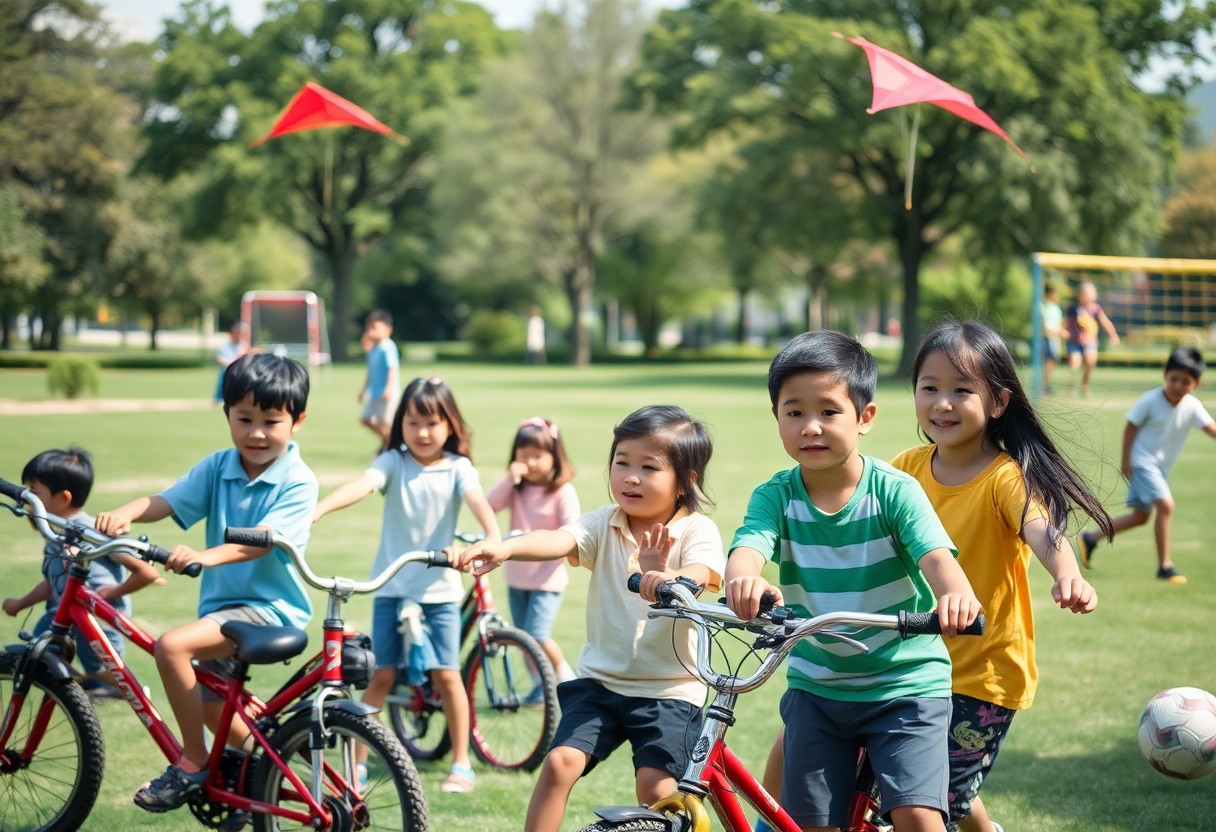Understanding the Importance of Physical Activity
Your child’s physical activity levels are more than just a measure of fitness; they play a vital role in their overall health and development. With the American Heart Association recommending that children ages 6-17 engage in at least 60 minutes of moderate to vigorous physical activity each day, fostering an active lifestyle can lay the groundwork for lifelong habits that promote well-being.
Health Benefits for Children
With increased physical activity, your child can enjoy numerous health benefits, such as maintaining a healthy weight, developing stronger bones and muscles, and experiencing improved brain function. Active children are also less likely to face issues like anxiety and depression, fostering better emotional health.
Long-Term Impacts on Lifestyle
With a strong foundation of physical activity established in childhood, your child is more likely to carry those habits into adulthood. Understanding this connection can motivate you to prioritize activity in their daily routines. Children who remain active tend to enjoy better cardiovascular health, lower risks of weight-related illnesses, and overall improved quality of life.
Understanding the long-term impacts of instilling active habits is crucial. Children who engage in regular physical activity are not only more inclined to maintain a healthy weight and robust heart health but also often experience enhanced academic performance. This continues into adulthood, as active individuals face lower risks of chronic diseases and mental health issues, making it vital for you to encourage a physically active lifestyle from an early age.
Modeling an Active Lifestyle
While encouraging your child to be more physically active, one of the most effective approaches is to model an active lifestyle yourself. Children often mirror the behaviors of their parents, so by demonstrating your commitment to regular physical activity, you can inspire your child to embrace similar habits.
Family Activities and Participation
For you and your family, creating opportunities for fun, active outings can foster a love for physical activity. Engage in group activities like hiking, biking, or even playing a friendly game of soccer in the park. These shared experiences not only strengthen family bonds but also promote a culture of movement within your household.
The Role of Parents as Role Models
Between busy schedules and the lure of digital distractions, it’s easy to overlook your impact as a role model for your child’s activity levels. Your actions set the tone for healthy habits at home. If you’re regularly active, it encourages your child to prioritize exercise too, aligning with the American Heart Association’s recommendation of at least 60 minutes of daily physical activity for kids and teens.
Also, showcasing a positive attitude towards exercise makes it more appealing. Share your experiences—whether it’s how you feel energized after a workout or the satisfaction of achieving a fitness goal. When your child sees you investing time and effort into staying active, they’re more likely to view physical activities as enjoyable and worthwhile, leading to a lifelong appreciation for fitness.
Making Physical Activity Fun
It is important to make physical activity enjoyable for your child. When kids perceive activity as play rather than exercise, they are more likely to engage. Introducing a variety of activities can help keep things fresh and exciting.
Exploring Different Types of Activities
Among the activities you can encourage your child to try, consider options that cater to their interests and abilities. Each child is unique, and finding the right fit can lead to lifelong habits of movement.
| Activity Type | Examples |
| Individual Sports | Running, swimming, cycling |
| Team Sports | Soccer, basketball, baseball |
| Dance | Ballet, hip-hop, jazz |
| Outdoor Fun | Hiking, climbing, park games |
| Active Games | Tag, hide and seek, scavenger hunts |
Recognizing your child’s preferences will help them develop a love for movement, promoting active habits that can last a lifetime.
Fostering a Positive Attitude towards Movement
Positive reinforcement is a powerful tool in encouraging your child’s active participation. By celebrating their efforts and achievements, you instill a sense of accomplishment that motivates them to continue. In addition to praise, you can create a supportive environment that emphasizes effort over skill and encourages exploration.
Another effective strategy is to engage in activities together. By participating alongside your child, you not only model an active lifestyle, but you also make physical activity a shared experience, strengthening your bond. Aim to focus on fun and enjoyment rather than performance, which can significantly reduce any anxiety your child may feel about participating in physical activities. This approach helps cultivate a more enthusiastic outlook on movement, making them more likely to embrace it as part of their daily routine.
Reducing Screen Time
To encourage a more active lifestyle for your child, reducing their screen time is necessary. The rise in digital entertainment has led to increased sedentary behavior, which is linked to numerous health risks, including obesity and decreased physical fitness. Children who spend excessive time in front of screens often miss out on physical activity opportunities, affecting their overall health and development.
Effects of Sedentary Behavior
Screen time can have significant negative effects on your child’s health. Studies suggest that excessive sedentary behavior increases the risk of weight gain, poor cardiovascular health, and diminished mental well-being. The American Heart Association emphasizes the importance of an active lifestyle, noting that children who are sedentary may also struggle with focus and academic performance.
Strategies for Limiting Screens
One effective approach to limit screen time is setting specific daily limits for your child. Establish clear rules about when and for how long they can use screens, ensuring that these limits are balanced with physical activity time. Encouraging other fun activities, such as sports or outdoor play, can also provide engaging alternatives to screen time.
This strategy can be further supported by creating a family routine that includes designated screen-free hours. Encourage your child to engage in physical activities during these times, whether it’s a family bike ride or playing outside with friends. By actively participating in these alternatives with them, you can foster a healthier balance and help your child develop a love for movement.
Providing Opportunities for Physical Engagement
Once again, fostering physical activity in your child requires intentionality in providing opportunities for engagement. By creating an environment that promotes movement and exploration, you can inspire your child to embrace an active lifestyle.
Outdoor Play and Exploration
Play is necessary for your child’s development. Encourage outdoor play and exploration to spark their creativity and imagination while simultaneously promoting physical activity. Activities like climbing trees, riding bikes, or playing tag keep kids moving, fostering not only their physical fitness but also their emotional well-being.
Access to Recreational Facilities
To support your child’s active lifestyle, ensure they have access to recreational facilities. Local parks, sports complexes, and community centers can provide spaces for various activities, from swimming and basketball to soccer and dance. Explore these options together to find something your child enjoys.
Engagement in these facilities can significantly impact your child’s activity levels. Data from the American Heart Association highlights that children who participate in organized sports and recreational activities are more likely to reach the recommended 60 minutes of daily activity. Encourage your child to take advantage of these community resources, helping them discover new interests and stay active.

Encouraging Sports and Group Activities
Not only does engaging in sports and group activities provide physical benefits for your child, but it also nurtures social skills and a sense of belonging. By participating in team settings, children learn valuable lessons in teamwork, communication, and discipline. These experiences contribute to improved mental health, self-esteem, and opportunities for lasting friendships while helping them meet the American Heart Association’s recommendation of 60 minutes of daily physical activity.
Benefits of Team Sports
For many children, team sports offer a fun and engaging way to stay physically active while forming connections with peers. Involvement in these activities often leads to healthier lifestyle choices, better academic performance, and reduced stress and anxiety. Active participation fosters a love for movement and encourages a spirit of friendly competition, ultimately helping your child develop a lifelong appreciation for physical activity.
Exploring Individual Sports and Dance
After assessing your child’s interests, you may find that individual sports or dance might better suit their personality. These activities provide excellent outlets for self-expression and personal achievement, which can boost your child’s confidence and motivation levels.
Individual sports such as swimming, running, or martial arts allow your child to set personal goals and measure their progress independently. Similarly, dance can be an exciting way for them to explore movement while enhancing flexibility, coordination, and balance. By tailoring options to your child’s strengths and preferences, you can encourage them to become more engaged in physical activity in a way that resonates with their interests.

Promoting Safe Transportation Methods
Many parents are looking for effective ways to increase their child’s physical activity levels through transportation methods. Encouraging walking and biking not only helps kids stay active but also instills a sense of independence and responsibility.
Walking and Biking to School
By incorporating walking or biking to school into your family’s routine, you can contribute to your child’s daily physical activity. The American Heart Association recommends at least 60 minutes of moderate to vigorous activity each day, and walking or biking can easily help meet that goal. Plus, this time spent outdoors can improve your child’s mood and engage them in their environment.
Safe Routes for Active Travel
Promoting safe routes for active travel is crucial for ensuring that your child feels secure while walking or biking. You can work with your local community to identify safe paths, crosswalks, and bike lanes that allow your child to travel without unnecessary risks.
Plus, engaging with your community to establish safe routes can encourage others to join in, making it a collective effort. You can also participate in local programs or initiatives that teach children safe walking and biking practices. Empowered by safety knowledge and a supportive environment, your child is more likely to enjoy these active transportation methods and develop lifelong healthy habits.
Supporting Children with Unique Needs
Unlike their peers, children with unique needs may face additional challenges when it comes to physical activity. However, with the right approach, you can help foster an environment that supports their participation and enjoyment of movement. By understanding their individual abilities, you can provide tailored opportunities for engagement that promotes health, confidence, and well-being.
Inclusive Activities for All Abilities
Below are various inclusive activities that allow children of all abilities to participate and enjoy physical activity together. These can include adaptive sports, dance classes, or simple community games designed to accommodate everyone. Emphasizing teamwork and collaboration helps build a sense of belonging and encourages kids to engage in physical activity without the fear of judgment.
Encouragement for Overweight or Uncoordinated Children
Supporting your child who may be overweight or uncoordinated requires sensitivity and positive reinforcement. This means focusing on their efforts and celebrating small successes rather than strictly on performance. Encourage them to try various activities that pique their interest, allowing them to discover what they enjoy most. The goal is to create an atmosphere where movement becomes a fun and rewarding experience.
This journey towards physical activity is unique for every child, especially those who may struggle with coordination or weight. Gradually increasing activity levels and setting achievable goals can help your child build both confidence and competence. Incorporate activities that align with their interests—be it swimming, cycling, or group games—while providing support throughout the process. Ultimately, fostering a love for movement is key to establishing lifelong healthy habits.


